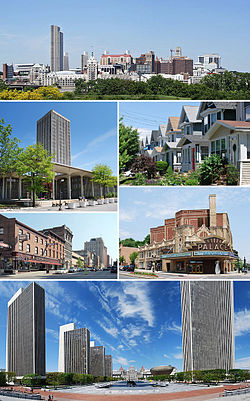Albany New York
| Albany, New York | |||
|---|---|---|---|
| City | |||
| City of Albany | |||

Clockwise from top: Albany skyline from Rensselaer; middle-class housing in the Helderberg neighborhood; Palace Theatre; Empire State Plaza from the Cultural Education Center; North Pearl Street at Columbia Street; and the State Quad at SUNY Albany.
|
|||
|
|||
| Etymology: Named for the Scottish Duke of Albany, whose title comes from the Gaelic name for Scotland: Alba | |||
| Nickname(s): Cradle of the Union | |||
| Motto: Assiduity | |||
 Boundaries of and major thoroughfares through Albany |
|||
 Location in Albany County and the state of New York. |
|||
| Location in New York, United States & North America | |||
| Coordinates: 42°39′09″N 073°45′26″W / 42.65250°N 73.75722°WCoordinates: 42°39′09″N 073°45′26″W / 42.65250°N 73.75722°W | |||
| Country |
|
||
| State |
|
||
| Region | Capital District | ||
| County | Albany | ||
| Settled | 1614 | ||
| Incorporation | 1686 | ||
| Government | |||
| • Type | Albany City Hall | ||
| • Mayor | Kathy Sheehan (D) | ||
| Area | |||
| • City | 21.94 sq mi (56.81 km2) | ||
| • Land | 21.39 sq mi (55.40 km2) | ||
| • Water | 0.55 sq mi (1.42 km2) | ||
| • Metro | 6,570 sq mi (17,000 km2) | ||
| Highest elevation (Near a reservoir off Birch Hill Road.) | 378 ft (115 m) | ||
| Lowest elevation (Sea level (at the Hudson River) | 0 ft (0 m) | ||
| Population (2010) | |||
| • City | 97,856 | ||
| • Estimate (2016) | 98,111 | ||
| • Density | 4,587.20/sq mi (1,771.11/km2) | ||
| • Metro | 1,170,483 | ||
| • Metro density | 180/sq mi (69/km2) | ||
| Time zone | Eastern (EST) (UTC-5) | ||
| • Summer (DST) | EDT (UTC-4) | ||
| ZIP Code | 12201-12, 12214, 12220, 12222-32 | ||
| Area code | 518 | ||
| Geocode | 977310, 978659 | ||
| ISO 3166 code | 36-01000 | ||
| FIPS code | 36-01000 | ||
| GNIS feature ID | 978659 | ||
| Demonym | Albanian | ||
| Website | www |
||
Albany (/ˈɔːlbəni/ AWL-bə-nee) is the capital of the U.S. state of New York and the seat of Albany County. Roughly 150 miles (240 km) north of New York City, Albany developed on the west bank of the Hudson River, about 10 miles (16 km) south of its confluence with the Mohawk River. The population of the City of Albany was 97,856 according to the 2010 census. Albany constitutes the economic and cultural core of the Capital District of New York State, which comprises the Albany-Schenectady-Troy, NY Metropolitan Statistical Area, including the nearby cities and suburbs of Troy, Schenectady, and Saratoga Springs. With a 2013 Census-estimated population of 1.1 million the Capital District is the third-most populous metropolitan region in the state and 38th in the United States.
Fortune 500 companies with offices in Albany include American Express, J.P. Morgan and Chase,Merrill Lynch,General Electric, Verizon, Goldman Sachs,International Paper, and Key Bank. In the 21st century, the Capital District has emerged as a major anchor of Tech Valley, the moniker describing the technologically-focused region of eastern New York State. This was the first European settlement in the state. It was settled by Dutch colonists who in 1614, built Fort Nassau for fur trading and Fort Orange in 1624. They formed successful relations with both the Mahican and the Mohawk peoples, two major Native American nations in the region. The fur trade attracted settlers who founded a village called Beverwijck near Fort Orange. In 1664 the English took over the Dutch settlements, renaming the city as Albany, in honor of the then Duke of Albany, the future James II of England and James VII of Scotland. The city was officially chartered in 1686 under English rule. It became the capital of New York State in 1797, following the United States gaining independence in the American Revolutionary War. Albany is one of the oldest surviving settlements of the original British thirteen colonies, and the longest continuously chartered city in the United States. Its charter is possibly the longest-running instrument of municipal government in the Western Hemisphere. During the late 18th century and throughout most of the 19th, Albany was a center of trade and transportation. It is on the north end of the navigable Hudson River, was the original eastern terminus of the Erie Canal connecting to the Great Lakes, and was home to some of the earliest railroad systems in the world. Albany's main exports at the time were beer, lumber, published works, and ironworks. Beginning in 1810, Albany was one of the ten most populous cities in the United States, a distinction it held until the 1860 census.
...
Wikipedia





